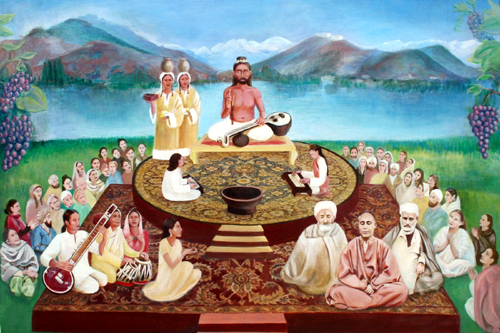Akhilesh Nagari
“Shiv chui thali thali manz rozan kya gauv hind ta kya gav muslman” i.e. “Shiv resides in each and every human being then what is the difference between Hindu and a Muslim”these are the famous lines of Lal Ded who all her life practiced Shaivism. Her poetry is still there in the heart of Kashmiris. How come she got this thought at the time when there was hatred everywhere? To know this, we need to know about Shaivism, which gave her the power for which she was known as the Lalla the yogini.
Shaivism of Kashmir developed between the eight and the twelfth centuries of the Christian era. This is a comparatively younger philosophy which tries to explain all such ambiguities which the ancient philosophers have failed to resolve. Like AdvaitaVedanta it is monistic, likeVaishnavism it is theistic, like yoga it is practical, like Nayaya it is logical and is also appeasing like Buddhism. Kashmir Shaivism is, therefore, idealistic and realistic in essence, strongly advocating a pragmatic approach to life.
Somananda, the first theologian of monistic Shaivism, was the teacher of Utpaladeva, who was the grand-teacher ofAbhinavagupta.
Kashmir Shaivism is philosophically similar to yet distinguished from Advaita: both are non-dual philosophies that give primacy to Universal Consciousness (Chit or Brahman). However in Kashmir Shaivism, all things are a manifestation of this Consciousness but the phenomenal world Shakti is real, existing and having its being in Consciousness (Chit),while Advaita Vedanta holds that the supreme, Brahman, is inactive (nishkriya) and that the phenomenal world is an illusion (maya).
Kashmir Shaivism is a householder religion based on a strong monistic interpretation of the Bhairava Tantras.There was additionally a revelation of the Shiva Sutras to Vasugupta. Kashmir Shaivism claimed to supersedeShaiva Siddhanta, a dualistic tradition which scholars consider normative tantric Shaivism. The goal of Shaiva Siddhanta is to become ontologically distinct Shiva by recognizing oneself as Shiva who, in Kashmir Shaivism’s monism, is the whole universe.
The point of view of Kashmir Shaivism can be summarized in the concepts of chit,mala, upaya and moksha, as follows.
* Chit: Universal Consciousness (chit) is the fundamental stuff of the universe. This Consciousness is one and includes the whole. It could also be called God or Shiva.
* Mala: Consciousness contracts itself. The one becomes many. Shiva becomes the individual (jiva). This contraction is called mala (impurity). There are three malas, the mala of individuation (Anava mala), the mala of the limited mind (mayiya mala), and the mala of the body (karma mala).
* Upaya: An individual caught in the suffering of embodied existence, afflicted by the three malas, eventually yearns to return to his or her primordial state of Universal Consciousness. To attain this, he or she undertakes seemingly difficult sadhana or spiritual practice. While most other paths observe offering incense and external objects to the deity, this path takes on to offering breaths. The individual controls his heart and pulse by reducing it significantly. The final stage is renouncing consumption of food and water. As a result, s/he connects the state of the supreme in the form of Shiva which results in purification of the body and generation of ojas. However, Kashmir Shaivism describes four methods (upayas): anvopaya, the method of the body, saktopaya, the method of the mind,sambhavopaya, the method of Consciousness, and anvopaya the ‘method less’ method.
*Moksha: The fruit of the individual’s sadhana is the attainment of Self-realization (moksha). In Kashmir Shaivism, the state of liberation (mukti) is called Sahaja Samadhi and is characterized by the attainment of unwavering bliss-consciousness while living one’s ordinary life.
For me, Kashmiri Shaivism offers a purest and most essential “notion” of enlightenment, one that I find particularly accessible.
In Kashmiri Shaivism “enlightenment” is simply clear and present consciousness that we are carefully unified with the world, with each other, with the universe, all else, animate and inanimate.
The opposite of unity is “dualism”. It refers to the understanding and experiencing that we are separate from all else. In this case, there is I, and there is everything else. In Kashmir Shaivism, dualism is considered delusional and the fundamental root cause of humanity’s ignorance and suffering. Certainly, this ignorance plays a key part in man’s destruction of man and of the planet.
In Shaivist parlance, enlightenment is knowing, experiencing, and living “unity”. In the end I just want to say that Kashmir Shaivism is fading away and it should be the responsibility of parents that they should pass on this great legacy to their future generation. So we can not only protect it but also spread it through all over the world.


